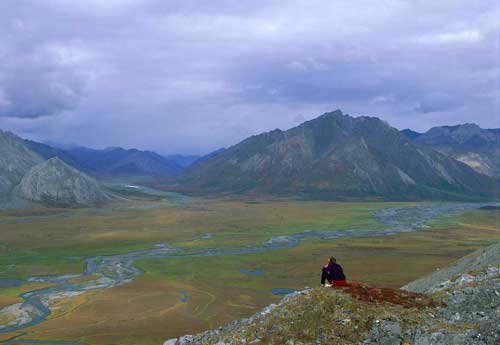
(Anchorage) — For the first time in more than 30 years, new harvest restrictions will be placed on the troubled Western Arctic and Teshekpuk caribou herds. The Alaska Board of Game, meeting in Anchorage last week, voted unanimously to adopt the restrictions crafted in a cooperative effort by the board, department and residents of communities spanning northern Alaska.
“I would like to recognize the sense of cooperation involved in this decision,” Kotzebue wildlife biologist Jim Dau told the board.
“All these villages and advisory committees are willing to restrict themselves, willing to take a hit to conserve caribou,” said Dau, who has studied and managed the Western Arctic herd (WAH) for more than 25 years. “It’s really amazing given the importance of caribou to subsistence users, and I would have to say working with the villages and the advisory committees on this is one of the highlights of my career.”
The new regulations, which will affect resident and nonresident hunters by lowering bag limits and reducing hunting season lengths, will go into effect on July 1, 2015.
In presentations to the board, Dau and colleague Lincoln Parrett, a Fairbanks-based wildlife biologist who closely tracks the Teshekpuk caribou herd (TCH), which ranges immediately east of the WAH, each traced the herds’ declines. The WAH, Alaska‘s largest caribou herd, numbered about 235,000 animals in July 2013, Dau said. That’s a decrease from 325,000 caribou estimated in 2011, and far below the peak of 490,000 animals in 2003.
Parrett described a similarly alarming pattern in the TCH, tracing the herd’s decline from 55,000 animals in 2011, to 32,000 in 2013, to fewer than 25,000 projected in 2015.
“Caribou numbers fluctuate naturally,” said Dau, who believes weather and predation have affected WAH numbers in recent years. “Disease does not appear to be a factor, caribou have generally been in good body condition throughout this decline, and we don’t think harvests initiated it. But, if harvests remain stable, they will increasingly affect the population trend as herd size goes down.”
Parrett believes calf survival is a factor in the TCH decline. “Annual calf survival is 30 percent,” he said. He added that, unlike the WAH, nutritional stress seems to be driving the decline in TCH caribou. Winter weather, insect harassment, and range degradation all appear to play a role in decreased body condition.
“Predation is a further aggravating factor,” said Parrett, “and the risk of predation may even be exacerbated by poor body condition.”
Both caribou herds are critical to thousands of northern Alaska residents, providing the primary year-round source of red meat in a region where commercially sold beef is consistently expensive and sometimes not an option. A large contingent of area residents traveled to Anchorage from Kaktovik, Kivalina, Barrow, Buckland, Wainwright, Nome, Nuiqsuit, Point Hope, Kiana, Unalakleet, Kotzebue, Kobuk, Noatak and beyond to share with the board their growing concerns and ideas about maintaining these caribou herds.








